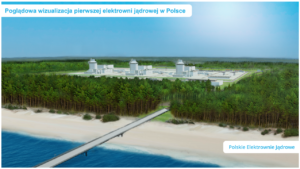The sabotage of the Nord Stream 1 and 2 gas pipelines has turned into reality what only a year ago seemed preposterous. What many observers warned about is becoming a reality – writes Mariusz Marszałkowski, editor at BiznesAlert.pl.
February 24th and Russia’s invasion of Ukraine have changed a lot in terms of the popular perception of the concept of security. It has become considerably more complicated, especially when it comes to its offshore version. While analyzing projects to diversify the supply of energy commodities to Poland I have penned many articles about how Poland „became dependent” on the Baltic Sea. Just as often, I wrote about the fact that for years there had been no interest in the Navy as a tool for protecting this infrastructure. But today is a special time because something has happened that many people have warned about before. The explosions of the Nord Stream 1 and Nord Stream 2 gas pipelines mean that the Baltic Sea is no longer a safe and stable water area. The sabotage means that the Baltic Sea has become a field of confrontation between Russia and NATO.
Countering Russia’s hostile intentions towards the energy infrastructure of Western countries in the Baltic requires both forces and resources within individual states, but also coordination of actions and close cooperation at the NATO level.
In recent years, entire energy infrastructure – production, drilling, offshore wind farms, as well as transmission and transport-transshipment, has been built or is being built in the Baltic Sea. The density of these facilities means more offshore security is needed to protect this infrastructure.
How to protect critical offshore infrastructure?
Key roles in securing critical infrastructure in the Baltic Sea are played by the Navy and the Border Guard, specifically the Maritime Border Guard Unit. Both these formations have the technical capabilities to monitor Poland’s maritime area. The Border Guard area is restricted to territorial waters due to the potential for impact (including observation points located on the coast, or small patrol units). The Navy operates beyond territorial waters. However, these forces are small, not adapted to the current challenges, and even more so to those that may emerge in a few years.
The Nord Stream explosions show that some Western countries have sufficient capabilities to respond. Naval forces were sent to the site of the explosion. The Danes sent the Absalon frigate, while Germany’s Deutsche Marine patrol used the Sachsen frigate along the pipe. In addition, other ships of both the Swedish and German navies took part in the inspection of the pipeline.
However, in order to properly approach the topic of protecting offshore energy infrastructure, it is necessary to understand that this is a multi-threaded and very complex challenge, in which many actors play a role. Dawid Kamizel, an expert and military analyst, points out that cooperation between many parts of the state is crucial. „It is important to recognize the threat before the kinetic phase of the task, e.g. a sabotage, has happened. This requires close cooperation between, among others, intelligence services, which provide information that is necessary to make specific decisions,” the expert explained.
Kamizela also clarified that today the Baltic Sea, like the Atlantic Ocean during the Cold War, was an arena of rivalry and potential clashes with Russia – „the Baltic, like the Atlantic, is de facto a NATO basin. Especially when Finland and Sweden join the Alliance. In this case, NATO will have it much easier to neutralize the threat from the Russian Navy,” he said.
„First of all, what constitutes the strength of NATO are certain bottlenecks that the ships of the Russian Navy have to go through, which can be and probably are constantly monitored by NATO forces. Thos include the Gulf of Finland, the Kaliningrad Oblast and the Danish Straits. The monitoring can be conduced by, among others, acoustic barriers,” Kamizela stated.
Acoustic barriers detect anomalies associated with noise, including propellers of a submarine. Once detected, an alarm is sounded. The barriers can be permanently mounted on insecure areas.
According to our interlocutor, another element of ensuring security in the Baltic is the possession of adequate naval capabilities, both surface and underwater. „Sweden, Finland and Denmark have submarines equipped with modern sonar systems that are able to detect enemy submarines. But to be fully content we also need submarines that are able to stay hidden, and can detect and recognize potential danger. This type of submarine operation was somewhat tested during the migration crisis in the Mediterranean. It was submarines that could secretly conduct observations of suspicious units, and once it was possible to identify a threat, mobile intervention teams joined the action, to check the spotted unit,” the expert said.
This meant the cost of solving the problem of organized crime that smuggled people to Italy and Greece was relatively low. That is because the alternative would be to use expensive air platforms, which would have to constantly monitor the indicated area.
Kamizela made an important point. The enemy’s goal may be to create a sense of danger and alert the security forces. Heavy offshore and airborne security generates high costs and creates distractions from potentially more dangerous activities. However, the expert believes that in time unmanned platforms may also come into play, as they could autonomously monitor selected areas.
Is there something next after Nord Stream?
The destruction of the Nord Stream 1 and 2 gas pipelines is a signal that the same thing can happen to any energy infrastructure in Europe, not just gas. The Russians have the appropriate experience, as well as the ability in the form of equipment to destroy any infrastructure located at the bottom of not only the Baltic Sea, but also the North Sea or the Atlantic Ocean. Beyond its capabilities, Russia also has an incentive to sabotage the West’s energy infrastructure. The most significant factor in this motivation are the coming winter months, that will be critical due to the limited supply of energy commodities to the Old Continent.
Poland needs to increase its ability to make impact on the sea, which, fortunately, has been already planned. The first stage of building its capabilities will include the construction of the Swordfish frigades. However, it is worth considering whether the delivery of these frigates should be accelerated. The turn of the 2020s and and 2030s was appropriate for a peaceful environment in Europe in 2021, when the preliminary agreements were signed. However, now we need these ships as soon as possible, and given what happened to Nord Stream, we need them now.









